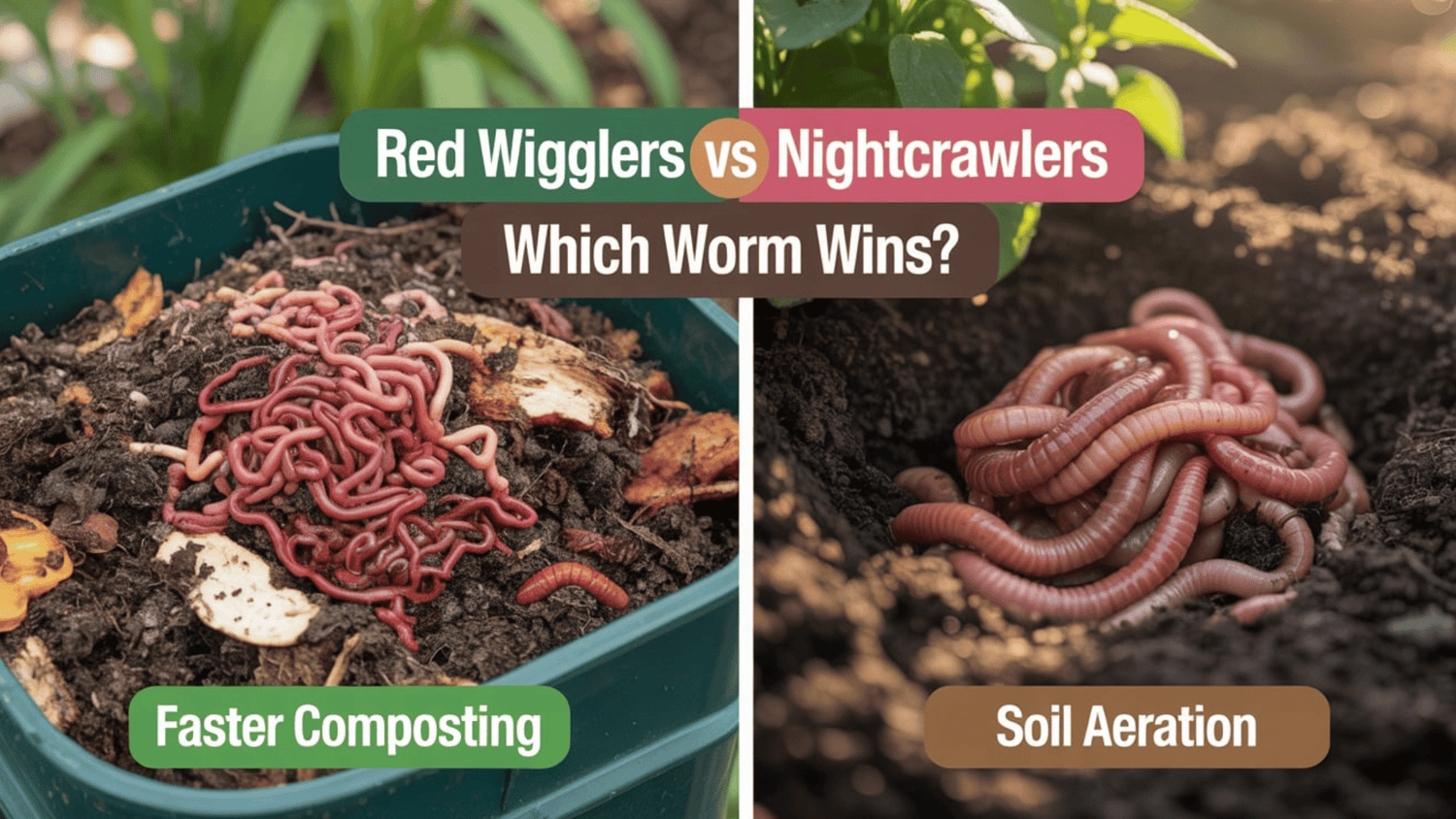If you're starting your worm composting journey or looking to expand your setup, you’ve probably run into the big question: Red wigglers or nightcrawlers? While both are technically earthworms, they’re far from interchangeable when it comes to composting success. In this guide, we’ll break down the differences, compare their strengths, and help you choose the right worm for your bin.
Whether you're managing a backyard compost bin, planning a worm farm, or just trying to find the best worm for fishing or garden aeration, this article will give you everything you need to make an informed decision.

What Are Red Wigglers?
Red wigglers(Eisenia fetida) are the go-to worms for composting. They thrive in shallow, oxygen-rich environments like worm bins and consume organic waste like kitchen scraps with impressive speed.
Key Traits:
-
Thrive in 55–80°F temperatures
-
Can eat half their body weight in food per day
-
Live near the surface, not deep underground
-
Reproduce rapidly (up to 3 cocoons per week, with 1–3 baby worms per cocoon)
How They’re Made: Red wigglers are usually raised through controlled vermiculture systems, where they are fed a high-quality diet of grains, peat moss, and veggie scraps. At Meme’s Worms, our red wigglers are raised with care to ensure strong genetics and premium castings.
What Are Nightcrawlers?
Nightcrawlers are the deep-divers of the worm world. Whether it’s the European Nightcrawler (Eisenia hortensis) or the Canadian Nightcrawler (Lumbricus terrestris), they’re better suited to outdoor garden beds than enclosed bins.
Key Traits:
-
Prefer deep, cool soil environments
-
Burrow vertically (unlike red wigglers)
-
Slower reproduction
-
Excellent for soil aeration, not compost bins
While they make great fishing bait and are incredible for loosening up clay-heavy garden soil, nightcrawlers struggle in compact compost bins. They need space to tunnel deep and often escape or die off in typical vermicomposting environments.
Not Ideal for Bins: Nightcrawlers will often attempt to burrow out of enclosed worm bins, and their slower reproduction and feeding rates mean they can't keep up with red wigglers in composting speed.
Worm Castings Comparison
Worm castings—aka "black gold"—are the end product of vermicomposting, and their quality matters.
| Feature | Red Wigglers | Nightcrawlers |
|---|---|---|
| Composting Speed | ⭐⭐⭐⭐ | ⭐⭐ |
| Reproduction Rate | ⭐⭐⭐⭐ | ⭐⭐ |
| Ideal Bin Conditions | Warm, moist, shallow | Cool, deep soil |
| Ease of Care | High | Moderate |
| Castings Quality | Excellent | Moderate |
✅ Takeaway: Red wiggler castings are superior when it comes to nutrient density and microbial content. That’s because their diet and bin environment are optimized for rapid decomposition. Nightcrawler castings are still beneficial but not nearly as concentrated or diverse in microbial life.

Red Wigglers vs Nightcrawlers for Worm Tea
If you’re brewing worm tea to use as a liquid fertilizer, red wigglers are the clear winner.
Why?
-
Their castings are more microbially active
-
They break down more food faster, giving you more material to brew
-

Important: Worm tea is not the same as leachate (the stinky liquid at the bottom of a worm bin). Real worm tea is brewed from castings in oxygen-rich water with a microbe food source like molasses.
Storage Note: Castings can be stored for weeks when dry. Worm tea, however, should be used within 24–48 hours of brewing or it may turn anaerobic.
Gardening Use: Which Worm Where?
If you're starting a garden or container planting, here's a quick comparison:
Use red wigglers for:
-
Composting food scraps
-
Creating worm castings
-
Feeding potted plants and raised beds

Use nightcrawlers for:
-
Tilling and aerating soil
-
Enhancing drainage in garden beds
-
Long-term soil structure improvement
In short: Use red wigglers to build your soil and generate rich fertilizer. Use nightcrawlers to maintain soil structure and health outdoors.
Red Wigglers vs Nightcrawlers for Fishing
This is where nightcrawlers shine. Their size, durability, and natural movement make them a favorite among anglers.
Fishing Comparison:
-
Nightcrawlers: Ideal for larger freshwater fish like bass, catfish, and trout
-
Red Wigglers: Better for smaller fish like bluegill and panfish

Tip: European nightcrawlers are a nice middle ground—they’re tougher than red wigglers but more adaptable than Canadian nightcrawlers.
Reproduction & Growth Rates
Understanding the reproductive habits and growth timelines of these worms is key when deciding which species suits your goals. Whether you're trying to ramp up your composting operation or maintain a balanced population in your bin or garden, these numbers matter.
Red Wigglers:
-
Reach maturity in 2–3 months
-
Each worm can lay up to 3 cocoons per week
-
Cocoons hatch in 3–4 weeks

Nightcrawlers:
-
Mature much slower (up to 6 months)
-
Lower reproduction rate
Result: Red wigglers multiply quickly, making them ideal for scaling up compost production.
Availability & Cost
Red wigglers are widely available from vermicomposting farms (like Meme’s Worms!) and are often cheaper due to higher supply and faster reproduction.
Nightcrawlers are usually sold in bait shops and garden centers, often at a premium because of their slower growth and seasonal availability.
Final Verdict: Which Should You Choose?
| Goal | Best Worm |
| Composting kitchen scraps | Red Wigglers |
| Producing worm tea | Red Wigglers |
| Fishing bait (large fish) | Nightcrawlers |
| Garden soil aeration | Nightcrawlers |
| Fast reproduction/growth | Red Wigglers |
Winner for Vermicomposting: Red Wigglers all the way!
If you’re building or expanding a composting system, red wigglers are easier to manage, reproduce faster, and produce superior castings. Whether you're a beginner or seasoned gardener, these worms are your composting MVPs.
Want to get started? Check out our high-quality red wigglers for sale at www.memesworms.com and get everything you need to start composting with confidence!



Leave a comment
All comments are moderated before being published.
This site is protected by hCaptcha and the hCaptcha Privacy Policy and Terms of Service apply.